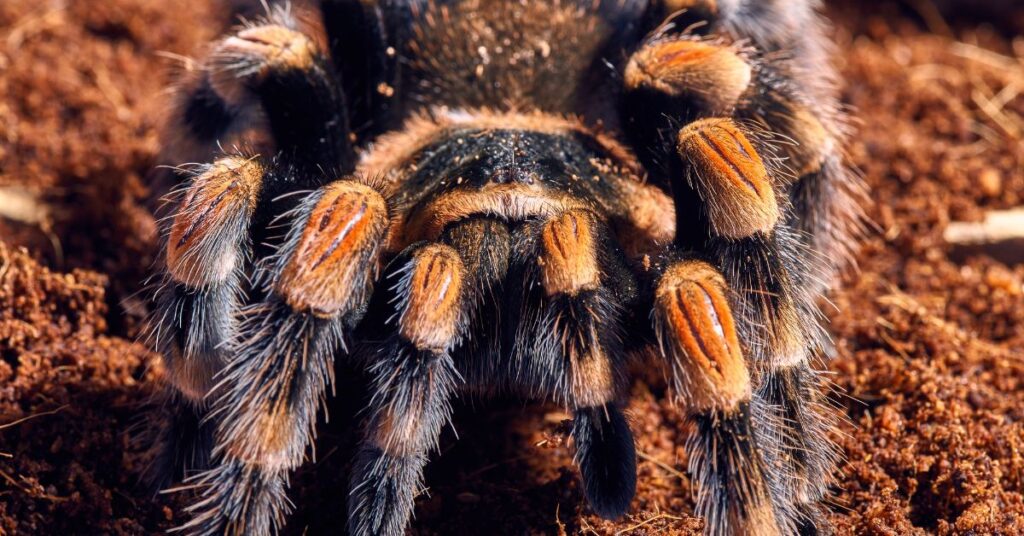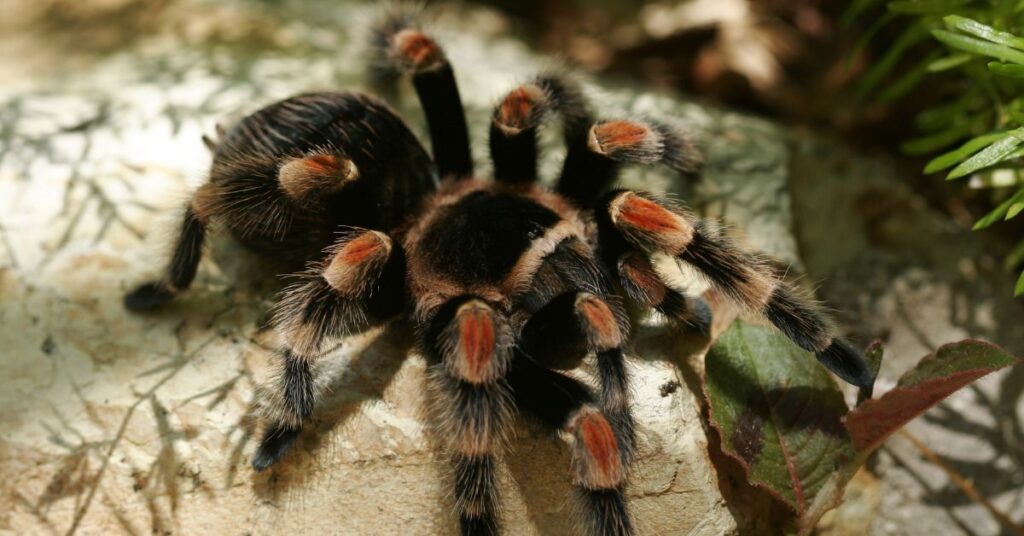
Welcome to our article all about the Mexican Red Knee tarantula (Brachypelma hamorii). Probably one of the more popular tarantulas for hobbyists, the Mexican red knee tarantula is often confused with the Brachypelma Smithii as the two species have very similar color patterns.
However, when viewed from above, the chelicerae of B. hamorii have two brownish-pink bands on a greyish background, not visible on all individuals. B.smithii lacks these bands.
The Mexican Red Knee tarantula is one of the most popular species of tarantulas in the world, and its stunning coloration, docile nature, and hardiness make it perfect for novice and expert alike. Let’s take a closer look at this delightful arachnid!
Appearance & Coloration
The Mexican red knee tarantula is easily recognizable by its distinct coloring. Its body is black with white markings on its legs that resemble stripes or bands around each segment.
These stripes form a bright yellowish-orange patch near the joints of the leg segments, which give this species its common name – the “Mexican red knee” tarantula.
In addition, they have long hairs all over their bodies that give them an almost fuzzy appearance.
The Mexican Red Knee is a relatively large tarantula. Adults are between four to five inches with a legspan of six to seven inches with males tending to have slightly shorter bodies.
Adult males differ slightly in appearance to females, in that they possess a light greyish-red area around the border of the carapace with a darker reddish-black marking from the middle of the carapace to the front of the head; the upper surface of the abdomen is black.

Adult females vary more in carapace color and pattern. The carapace may be mainly black with a brownish-pink border, or the dark area may be broken up into a “starburst” pattern with pale orange–yellow elsewhere.
Males tend to live for five years and females for 30 years. They are a slow maturing tarantula and could take anywhere from three to seven years to mature.
Habitat & Diet
Mexican red knee tarantulas can be found in warm, dry climates along the Pacific Coast of Mexico.
The natural habitat of the species is in hilly deciduous tropical forests. It constructs or extends burrows under logs, rocks, and tree roots, among thorny shrubs and tall grass.
Female Mexican Red Knee tarantulas spend most of their lives in their burrow which are typically located in or near vegetation.
Their diet consists mainly of small insects such as crickets and mealworms, as well as other small invertebrates like spiders and centipedes. They can also eat small lizards or frogs if necessary.
Watch this video of my favourite tarantula keeping Youtuber (The Dark Den) feeding his babies.
Molting
As with all tarantulas, the Mexican Red Knee sheds it’s exo-skeleton when it is grows. We have a complete breakdown on the molting process right here on Spider Advisor.
Care & Handling
Mexican red knee tarantulas are relatively easy to care for compared to other species which makes them a great beginner tarantula.
They do not require a lot of maintenance or special attention; however, they should be kept in an enclosure with plenty of ventilation and humidity levels between 50-70%.
It’s also important to provide them with hiding places such as logs or artificial plants so that they feel secure in their environment.
If you do plan to keep one of these gorgeous creatures, they should be housed in a terranium of a mininum size of 60x45x30cm.
When handling these spiders, it’s important to use caution since they are venomous, although their bite is not particularly dangerous to humans, its more akin to a bee-sting.
Do Mexican Red Knees need a heat lamp?
If keeping as pet, it is useful to know that the Mexican red knee doesn’t need any heating or lighting as long as your house stays at 65°-80°F.
If your house drops below that , a small portable heater is recommended to heat up the room.
As you can imagine, the Mexican Red Knee tarantula has become increasingly popular among hobbyists due to its docile nature and ease of care.
If you’re looking for an interesting pet spider that doesn’t require too much maintenance or special attention, then consider adding a Mexican red knee tarantula to your family.
At the moment, we don’t recommend any specific sellers but if you click on this link, you’ll get taken to a list of sellers near you!
Until next time, stay spidery!
